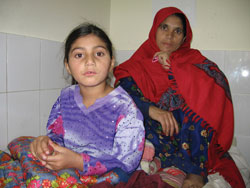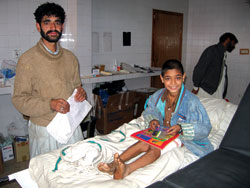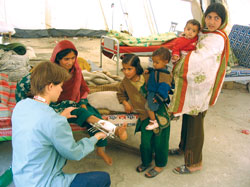When the earth shook
Medical response teams witness the people's strength and resilience in the aftermath of the quake in North East Pakistan
By Carolyn Beukeboom
February 2006
Return to Table of Contents
Print Article
Shortly after the 7.6 magnitude earthquake struck North East Pakistan on October 8, 2005, the Registered Nurses Association of Ontario sent out an appeal to all members. They reported that the Canadian Relief Foundation (CRF) was assembling medical response teams to help with relief efforts and needed volunteers. I applied to the CRF and was on my way to Pakistan a month later to work with the victims. I was part of a team of eight: one physician, two nurse practitioners, one paramedic and four nurses.
Prior to heading to our base camp in Muzaffarabad, we stayed for two days in Islamabad for a debriefing on UN security and safety procedures, as well as a training session on stress and coping. The Muzaffarabad region was one of the areas most affected by the earthquake that killed more than 86,000 people, left more than 67,000 people injured and four million people homeless.
The Muzaffarabad region was one of the areas most affected by the earthquake that killed more than 86,000 people, left more than 67,000 people injured and four million people homeless.
The journey to Muzaffarabad took about four hours on winding roads through beautiful mountain scenery. Some of the roads were partially destroyed because of the earthquake and landslides. Along with three members of the team, I was stationed at the wound clinic established by the Canadian Relief Foundation at the Local Government Pakistan Hospital.

Doing exercises with a patient who is accompanied by members of her family.
Credit: Nancy Stephens
Many people were there with fractured bones that had been fixed, but now these people had open wounds that needed daily dressing changes. I had never seen such horrific wounds. We worked closely with a team of orthopedic surgeons from Pakistan, Canada, the United States and Cuba. Never did I think that the Spanish I learned as a Scarboro missioner in Ecuador would come in handy in Pakistan. I was frequently asked to serve as a translator from Spanish to English and then someone else would translate to Urdu.
An international response
Many nongovernmental organizations (NGOs) from around the world were in the area and we tried to work closely together to refer specific cases to one another depending on the specialties of each team. Turkey, the United States and the International Red Cross all had their own tent hospitals in Muzaffarabad.
As new roads opened and medical teams went into remote villages, we began seeing patients who six weeks after the earthquake had not yet received medical treatment. People who had unstable bone fractures were coming to the clinic with their legs neatly wrapped in cardboard or wooden sticks. I wondered how many more people were out there still without treatment.
Shortly into our work in the wound clinic the team of American doctors noticed that there were patients lying stationary in bed, some for over a month. We started putting crutches together and getting the people up and walking and doing exercises. It was exciting when one by one people got up and others in the ward cheered them on and congratulated them for their achievements. We all shared feelings of joy knowing that people were recuperating and the smiles on their faces brightened our day.

One of our favourite little patients who always came to the clinic with a smile.
Credit: Carolyn Beukeboom
The hardest for me was seeing the children so frightened. Any pain inflicted on them during treatment was quite traumatic as many had been through so much already. For some it was the loss of parents or family members, or they were trapped in rubble for hours before being discovered and dug out. My most challenging little patient was a seven-year-old girl who was terrified to move her leg or bend her knee as a result of a fractured femur. We finally managed to get her to stand for just a few minutes. Hers will be a slow healing process. Child psychologists were also present and working with the many patients at the hospital. With stickers, balls and hair elastics I did manage to create a few smiles through their tears.
Learning about the people
While treating patients we learned a lot about the present situation and cultural issues within Pakistan. One day I went with members of the team to set up a mobile clinic in a village on the outskirts of town. Many of the women had lost their male partners and male family members and were not permitted to leave their houses unless accompanied by a male member of the family. Thus, they were finding it hard to receive medical treatment. With a physician, two nurse practitioners and a nurse, we treated mostly ear, respiratory and skin infections and several villagers needed to be on antibiotics.

Traumatized by her experience of the earthquake, this little girl came for treatment with her mother, but would not walk or bend her knee for fear of further pain.
Credit: Carolyn Beukeboom
The Pakistani people, even those whose houses remain intact, no longer want to sleep in their homes. Every house has a tent beside it and although people may cook and do other activities during the day indoors, they will sleep in the tent at night. The fear of another earthquake is palpable. In a conversation with our interpreter many people believe that this earthquake was a punishment from Allah, because people have gone astray in following the ways of their Islamic religion.
One of our team members noted that we saw very few children between the ages of eight and 14. The earthquake struck at 8:52 in the morning. Schools normally start at nine o'clock, but it was Ramadan, the Islamic month of fasting, when schools begin half an hour earlier. So the majority of children were inside school buildings that were completely destroyed by the quake and many children died.
On our final day we said goodbye to people we had worked with and patients who had become dear to us. I walked out of the hospital with tears in my eyes. I was leaving, yet this was their life – a life of suffering, of pain, of injury and of incredible loss: loss of a mother or father, loss of a child or children, loss of family members, loss of a limb, loss of function in a leg or arm, loss of a home, and most of all, loss of a life that once was.
I was leaving with bittersweet memories knowing that while I was there I had done all I could to ease maybe a small part of their immense suffering. The people were so appreciative for any small or big gesture that we had done for them. And they continue on with strength, resilience, and the ability to rebuild their lives and to cope with the suffering they have endured.
Everyone came together for the common purpose of helping others despite race, culture or religion.
It was an incredible experience for me to take part in a relief effort that included people and nongovernmental organizations from all over the world. Everyone came together for the common purpose of helping others despite race, culture or religion. Our Canadian team worked well together, sharing knowledge and expertise. We shared living conditions much like winter camping in tents, with outhouses, cooking over gas stoves, sharing meals, conversations and the occasional campfires. But most of all we were a support to one another as we witnessed and felt the pain of the Pakistani people. I am thankful and honoured to have worked with such a dedicated and caring group of people.
Carolyn Beukeboom, former Scarboro missioner, presently works as a nurse practitioner at a Community Health Centre in London, Ontario. She works with a multicultural population.
Return to Table of Contents
Print Article